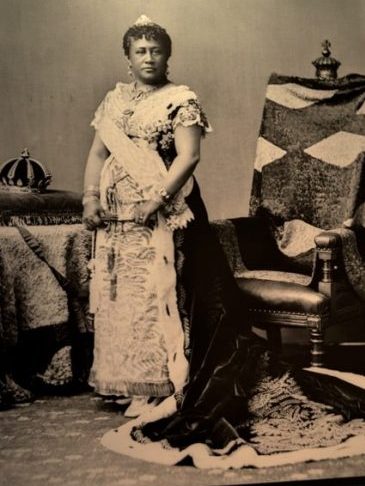On a recent visit to ‘Iolani Palace in Oahu, I paced off the room where our government had imprisoned Queen Lili’uokalani for almost a year. I tried to imagine how this well-educated, world-traveled woman maintained her spirits, sitting in that dark-paneled space, her only pastimes composing music and making a quilt of Hawaiian history with her female companion.
Queen Lili’uokalani was a descendant of King Kamehameha, who united the Hawaiian Islands in 1795. The king’s instinct had been to control interactions with foreigners, but his desires eroded with subsequent rulers, ultimately leading to the kingdom’s demise. By the mid-1800’s Hawai’i had a House of Representatives and had developed the concept of private ownership of land while foreigners planted sugar cane and developed trade relationships. By the late-1800’s Hawai’i was westernized, with electricity and royals who traveled the world.
Queens were often active advisers to their husbands, but it was not until 1891 that Queen Lili’uokalani became the First Woman Queen of Hawai’i to rule the “kingdom.” She had served as regent when King Kalakaua made a world tour in 1881. Proficient in English, she was greeted warmly by both President Grover Cleveland of the United States and Queen Victoria of England on her own world tour.
Queen Lili’uokalani disagreed with Hawaiian rulers who had relinquished some control of the islands to the United States by ceding the port of Pearl Harbor and giving the country favored trade status. When she became queen she attempted to reassert control through a constitutional revision. It only took American businessmen two years into her reign to demand her abdication and, supported by U.S. Marines, proclaim a Republic in Hawaii and set up a provisional government
Wishing to minimize blood shedding by her people, Lili’uokalani agreed to step down, without abdicating; she appealed to President Cleveland who was sympathetic to her cause. His representative found the overthrow to be illegal and ordered the reinstatement of the queen. However, no American troops were ever sent to enforce this decree.

“Aloha Oe” was written by the Queen during her house arrest.
A group loyal to the monarchy staged an insurrection and the newly established republic charged the queen with treason. She denied any complicity but surrendered to house arrest. Within a year she arranged to obtain pardons for her supporters by formally abdicating. Even though she attended the inauguration of President William McKinley, he was not sympathetic to her cause and annexed Hawaii in 1898.
I wonder if things might have been different had a king been in charge when the first coup attempt occurred. Would a king have gone to war? If so, Hawai’i would probably have lost both many lives and their cause, justifying the Queen’s reluctance to shed blood. On the more positive side, would a king have been confined to the palace after being accused of treason or simply shot by firing squad? Had the ruler been a king, would the coup have occurred in the first place? Was the uppity spirit of Queen Lili’kuolani part of what caused American businessmen to chafe under her rule?

